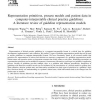Free Online Productivity Tools
i2Speak
i2Symbol
i2OCR
iTex2Img
iWeb2Print
iWeb2Shot
i2Type
iPdf2Split
iPdf2Merge
i2Bopomofo
i2Arabic
i2Style
i2Image
i2PDF
iLatex2Rtf
Sci2ools
IJMI
2002
2002
Representation primitives, process models and patient data in computer-interpretable clinical practice guidelines: : A literatur
Representation of clinical practice guidelines in a computer-interpretable format is a critical issue for guideline development, implementation, and evaluation. We studied 11 types of guideline representation models that can be used to encode guidelines in computer-interpretable formats. We have consistently found in all reviewed models that primitives for representation of actions and decisions are necessary components of a guideline representation model. Patient states and execution states are important concepts that closely relate to each other. Scheduling constraints on representation primitives can be modeled as sequences, concurrences, alternatives, and loops in a guideline's application process. Nesting of guidelines provides multiple views to a guideline with different granularities. Integration of
| Added | 22 Dec 2010 |
| Updated | 22 Dec 2010 |
| Type | Journal |
| Year | 2002 |
| Where | IJMI |
| Authors | Dongwen Wang, Mor Peleg, Samson W. Tu, Aziz A. Boxwala, Robert A. Greenes, Vimla L. Patel, Edward H. Shortliffe |
Comments (0)

